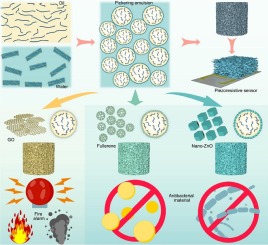Abstract
The structure and characteristics of carbon nanotubes (CNTs) aerogel (CNTA) make it capable of only compression, lacking the necessary toughness, flexural, and tensile properties. These limitations restrict its application. To overcome these obstacles, this study employed an interface modification and the Pickering emulsion strategy, using water-soluble CNTs as the continuous phase while silicone rubber (SR) as the dispersed phase, to successfully achieve the organic-inorganic combination and prepare the SR-CNTs composite aerogel (SRC). Benefiting from the synergistic effect of the "soft-hard" phase combination of SR (soft) and CNTs (hard), SRC exhibited good conductivity (1.23 S/m) and superior multi-axial mechanical properties such as compression (90 %), bending (360 degrees), degrees ), twisting (360 degrees), degrees ), and stretching (110 %), making it broad prospects in the field of flexible sensing. Importantly, the strategy employed in this study offers an innovative approach for a transition from low- dimensional nanomaterials to three-dimensional macroscopic overall structures. This approach effectively addresses common issues in traditional aerogel materials, such as mechanical brittleness and structural instability, which also allows for functionalization and customization, opening up new possibilities for the research and application of high-performance aerogels.

Keywords Plus:HYBRID AEROGEL,CARBON AEROGEL,LIGHTWEIGHT,FILM
Published in CHEMICAL ENGINEERING JOURNAL,Volume 489;10.1016/j.cej.2024.151378,JUN 1 2024


